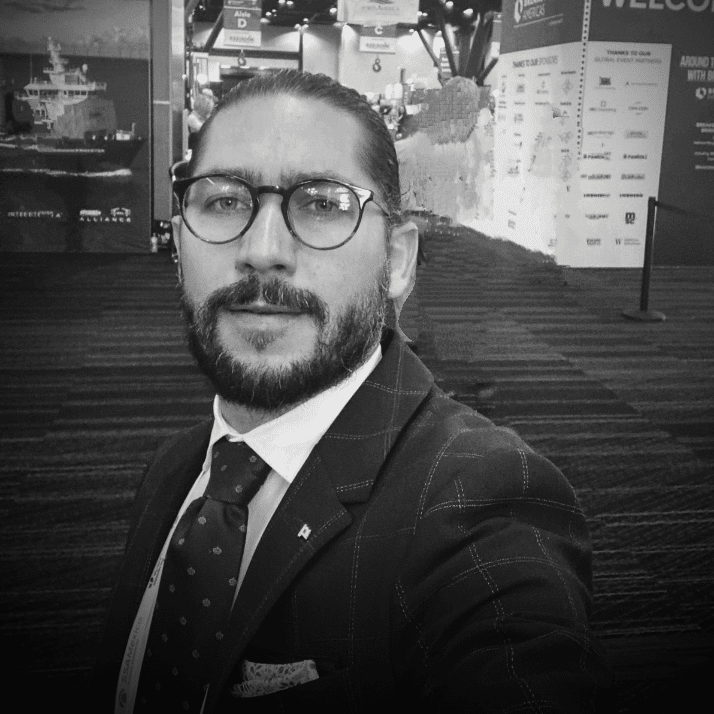It has been an eventful week with various updates related to contracts, including confirmations, terminations, and suspensions. Additionally, the Norwegian government accepted the first plan for development and operation of the year, and a final investment decision on a Namibian project is expected by the end of next year.
In case you missed it, you can access our previous Rig Market Roundup here.
Contracts
Burullus Gas Company, the self-operated joint venture between Shell Egypt, the Egyptian Natural Gas Holding Company (EGAS), the Egyptian General Petroleum Corporation (EGPC) and Petronas, has agreed to move forward with the development of Phase 11 in Egypt’s Nile Delta in the Mediterranean Sea. The development project is located in the West Delta Deep Marine (WDDM) concession. Currently, Burullus is drilling three wells as part of Phase 10 with Saipem’s 12,000-ft semisubmersible, Scarabeo 9. Phase 11, which will also comprise three wells, is anticipated to commence in late Q3 2024, immediately following the conclusion of Phase 10. With the confirmation of Phase 11, the joint venture has exercised its option for Scarabeo 9, keeping the rig busy in Egypt into 2025.
QatarEnergy has exercised a one-year option for Borr Drilling 400-ft jackup Groa, keeping it working in Qatar into April 2025. Groa has been working for QatarEnergy since April 2022. QatarEnergy has a further one-year option for the rig, which could keep it working until April 2026.
Following a letter of award announced earlier this month, Shelf Drilling North Sea has secured a contract for the 400-ft jackup Shelf Drilling Fortress with a North Sea operator for operations in the UK Continental Shelf. This campaign with an unnamed operator believed to be TotalEnergies is scheduled to begin following the completion of the rig’s current contract. The estimated duration of the new contract is 400 days with a contract value of approximately $54 million. The planned start-up of operations is August 2024 in direct continuation of the rig’s current contract with CNOOC.
Dolphin Drilling has issued a notice of termination of a contract to General Hydrocarbons Limited (GHL) for the 6,000-ft semisub Blackford Dolphin. Dolphin will now prepare the rig for transit to India. The Blackford Dolphin started its 12-month contract with GHL in Nigeria in March 2023. In November 2023, Dolphin reported that GHL had past due payments totaling $17.3 million. Dolphin received payments from GHL in January and February 2024. Following an agreement from March 2024 regarding past due payment amounts and remaining work under the drilling contract, Dolphin received a further payment and agreed for Blackford Dolphin to continue working for GHL, with the next payment due in late April 2024. On 30 April, Dolphin reported that the terms for payment under the agreement with GHL have not been met. The company therefore confirmed that it has, in accordance with the agreement, issued a notice of termination to GHL. The company will now prepare the Blackford Dolphin for transit to India in the near term ahead of a new contract with Oil India. Dolphin intends to pursue the recovery of sums remaining due by GHL.
Following a letter of intent (LoI), Transocean is working to firm up a new contract extension for its 10,000-ft semisub Transocean Spitsbergen in Norway. Transocean announced the LoI, which is subject to final partner approval, during the company’s 1Q 2024 earnings conference call on Tuesday 30 April as an example of customers booking further into the future. The LoI is for three firm wells for an estimated duration of 150 days, plus six priced option wells in direct continuation, which is currently anticipated to be July 2025. The rig owner said it would provide further details once the extension becomes a fully binding contract. The rig has been working for Equinor in Norway for years and the current contract is expected to end in April 2025. During the call, Transocean executives stated that the Norwegian harsh environment fleet remains sold out through 2025, also noting a shift in the customer procurement process where regional tenders are used less in favour of direct negotiation.
Transocean has secured a contract for an additional four wells for 12,000-ft drillship Deepwater Atlas in the US GOM at a dayrate of $505,000. The new contract is expected to run for between 240 to 360 days, in direct continuation of the rig’s current program. Deepwater Atlas has been working for Beacon Offshore Energy in the US GOM since late 2022, with its current program expected to continue into May 2025. The 2022-built Deepwater Atlas is equipped with a 1,700-ton hoisting system, a 10,000-psi mud system, and a 20,000-psi well control system. Transocean specified that the new four-well contract was for work rated at 15,000 psi.
ExxonMobil has exercised a six-month priced option offshore Angola for Valaris 12,000-ft drillship Valaris DS-9, starting in January 2025 in direct continuation of the rig’s existing firm program. Valaris DS-9 has been working for ExxonMobil offshore Angola since mid-2022. The newly exercised option is the second option to be exercised by ExxonMobil out of an original four six-month priced options available. The two remaining options would keep the rig working into mid-2026 if exercised.
Harbour Energy has sent a contract suspension notice to Valaris for 225-ft jackup Valaris 92, which has been working for Harbour Energy in the UK North Sea. The contract, previously scheduled to end in February 2026, will take effect from 26 February 2025 at the end of Harbour’s planned work scope. The contract suspension results in a reduction to Valaris’ contract backlog of around $35 million. The rig recently began what was intended to be a two-year contract extension for P&A work with Harbour in March 2024. Valaris 92 has been working for Harbour Energy and predecessor company Chrysaor since the first quarter of 2017.
Equinor has exercised a 60-day priced option offshore Brazil for Valaris 12,000-ft drillship Valaris DS-17, starting in May 2025 in direct continuation of the rig’s existing contract. Valaris DS-17 recently mobilised from Brazil to Argentina to drill the Argerich prospect for Equinor. After this well is complete, Valaris DS-17 will return to Brazil to continue work at the Bacalhau development. The operating day rate for the priced option period is around $497,000, including managed pressure drilling and additional services. Equinor exercised a previous 60-day option for the unit in January 2024.
Following the previously announced suspension of the Saudi Aramco contract for ARO Drilling-managed 350-ft jackup Valaris 143, ARO Drilling intends to terminate the contract and return the rig to its owner Valaris. Valaris 143 was originally scheduled to remain working for Aramco offshore Saudi Arabia into December 2024. Aramco issued a suspension notice to the unit in early April 2024, with the rig’s contract to be suspended in May 2024 for up to 12 months. ARO Drilling has notified Saudi Aramco that it will terminate the contract effective seven days after the suspension date. Upon termination, the bareboat charter agreement between Valaris and ARO Drilling will also be terminated and the jackup will be returned to Valaris’ management. ARO Drilling is a joint venture between Valaris and Saudi Aramco. ARO had bareboat chartered the rig for work in Saudi Arabia since 2018.
Valaris 350-ft jackup Valaris 144 has secured a 13-well contract offshore Angola, which will see the rig leave the US GOM in 2025 for the first time since 2021. The new contract is expected to commence in the second quarter of 2025, around April 2025, and has an estimated duration of between 730 days and 770 days. The total contract value is estimated at between $149 million and $156 million, including a mobilisation fee from the US GOM. Valaris did not disclose the name of the operator in this contract. However, market sources indicate that the rig will work for Azule Energy, an Angola-focused company created by bp and Eni. Valaris 144 recently finished work with Talos in the US GOM. The rig will undergo around 140 days of out of service time across the fourth quarter of 2024 and first quarter of 2025 for contract preparations and mobilisation. Valaris 144 is the only active jackup currently in the US GOM that is not managed by Enterprise Offshore Drilling. Once a busy area for jackups, demand in the US GOM has declined significantly over the past decade due to the increasingly mature status of the US GOM shelf and the competition of cheaper natural gas from onshore fields. At this time, there are 14 cold stacked jackups in US waters and another 6 that are drilling or warm stacked.
TotalEnergies has exercised a one-well priced option for the 400-ft harsh environment jackup Valaris Stavanger in the UK waters of the North Sea. The well has an estimated duration of 30 days and will be added to the jackup’s existing firm program, increasing the total contract value by around $4 million to a total of $52 million, which includes minor rig modifications. TotalEnergies also has two priced options for Valaris Stavanger with an estimated duration of 270 days each.
The 400-ft jackup Arabia I, owned by Borr Drilling, is currently on contract suspension for up to 12 months, and is on standby in Ras Tanura. On 4 April 2024, Borr Drilling announced the temporary suspension of Arabia I for a period of up to 12 months. Originally, the rig had been expected to remain on a contract with Saudi Aramco until the end of October 2025, with a possible one-year extension thereafter. Borr Drilling intends to seek alternative engagement for the rig while on suspension.
Drilling Activity and Discoveries
Following its positive appraisal of the Venus discovery offshore Namibia, TotalEnergies plans to take the final investment decision (FID) on the Venus development by the end of 2025. Speaking during the company’s Q1 2024 results call, CEO Patrick Pouyanné noted that he expected TotalEnergies to be the first company to produce offshore Namibia. TotalEnergies is also lining up additional work in the region, with plans to drill a prospect in the southern portion of the Orange Basin. TotalEnergies also has licenses in the South African waters of the Orange Basin, including a recently acquired interest in Block 3B/4B. TotalEnergies stated that it may drill offshore South Africa in 2025. TotalEnergies has been drilling offshore Namibia since 2023 with Odfjell Drilling-managed 10,000-ft semisub Deepsea Mira and Vantage Drilling 12,000-ft drillship Tungsten Explorer. Earlier this year, TotalEnergies created a 75%/25% joint venture with Vantage Drilling to acquire the Tungsten Explorer, which it will use for drilling over the next decade.
Bursa Malaysia-listed Hibiscus Petroleum has made an oil discovery at the Malaysia–Vietnam PM3 CAA PSC. According to Hibiscus, the company has successfully completed the drilling of the Bunga Aster-1 exploration well, ecountering approximately 17.5 metres of oil bearing sandstone with up to 46 metres of potential oil column. Hibiscus said it would progress with a thorough evaluation and appraisal of the discovery to further define the size of the discovery. The company also said it had plans to continue exploring other near-field prospects in the PM3 CAA PSC in the next three years. Hibiscus has been using the 400-ft PV Drilling III jackup rig for its wells in Malaysia and PM3 CAA PSC. The rig currently has a contract with Hibiscus running until October 2024.
The Norwegian Offshore Directorate (NOD) has granted Equinor a drilling permit for two wells in the North Sea off Norway. Included in the permit are exploration well 35/10-14 S and sidetrack well 35/10-14 A, targeting Kvernbit and Mimung prospects. They are located in production licence 1185, which is operated by Equinor with Vår Energi, Sval Energi, and Aker BP participating as partners. The wells will be drilled with the Odfjell Drilling-managed 10,000-ft semisub, Deepsea Stavanger. Operations are expected to begin in June 2024. The rig is currently firm with Equinor into late 2024 and it is expected to start a long-term contract with Aker BP in 2025.
Wintershall Dea and its partners, Petoro and DNO, have spudded the Cuvette exploration well next to the Vega field in the North Sea with the 10,000-ft semisubmersible Transocean Norge. The well 35/11-27 S, targeting the Cuvette prospect, is located in production license 248. Wintershall Dea was granted consent for the well in February 2024 and a drilling permit in early April 2024. Vega is a Wintershall Dea-operated oil, gas and condensate field comprising three subsea templates tied back to the nearby Gjøa platform. The Cuvette well will target a gas condensate prospect just south of the Vega Central template and infrastructure. The well is in line with the company’s strategy of proving new volumes in core areas close to existing infrastructure. The Transocean Norge rig, which is under a long-term contract with Wintershall Dea, has already drilled development wells in the Maria field in the Norwegian Sea, successfully appraised the Bergknapp and Adriana discoveries, and drilled production wells on the Nova field in the North Sea. During the rest of 2024 and 2025, it is scheduled to complete the Maria Phase 2 wells and begin drilling the Dvalin North development wells. It may also be used to drill additional wells for exploration and carbon storage licenses.
Oil and gas company LLOG started drilling the Who Dat East exploration/appraisal well on Sunday, 28 April, using the 12,000-ft drillship Noble Valiant. The well is located in the Mississippi Canyon Block 509, 27 kilometres (16.7 miles) east of the Who Dat Floating Production System (FPS), in a water depth of approximately 1,300 metres (4265 feet). The aim of the well is to appraise a gas/condensate discovery made in 2001 and test additional potential reservoir targets, in the Middle Miocene section. According to Karoon Energy, LLOG’s partner in the project who shared the drilling start news on Tuesday, the well will be drilled as a deviated hole with a total measured depth of around 7,900 metres (25918 feet) and will take about 55 – 60 days to drill and evaluate. Subject to the results, the well may be suspended as a potential future producer.
Deltic Energy, a partner in the Shell-operated Pensacola discovery in the UK North Sea, is struggling to secure a partner to help fund its share of drilling costs for the upcoming appraisal well amid fiscal uncertainty in the UK. The large Pensacola discovery is located on Licence P2252 in the Southern North Sea. Shell is the operator with a 65% interest, and Deltic (30%) and ONE-Dyas (5%) are its partners. Following a commitment to the appraisal well in December 2023, operational planning for the Pensacola appraisal well has continued to progress. The rig contract was entered into in February, securing the 400-ft jackup Valaris 123 for both the Selene exploration well and Pensacola appraisal well, with the Pensacola well due to be drilled immediately following the completion of Selene operations. The rig has recently started operating in the Central North Sea for Ithaca Energy following which it will move to Selene. Subject to the timing of the completion of Selene, the Pensacola well remains on track to be drilled in Q4 2024. Meanwhile, Deltic has been working to farm out its stake in the Pensacola licence. However, according to the company, the feedback from its farm-out process has indicated that the continual tinkering with the Energy Profits Levy (EPL) and resultant fiscal uncertainty created by the current government, along with recent rhetoric emanating from the Labour Party, have had a severely negative effect on the ability of UK E&P companies to commit to long term investments in the North Sea. This has resulted in many operators diverting capital away from the UKCS or delaying investment decisions, especially with respect to new large-scale opportunities like Pensacola, Deltic said. Against this political environment, Deltic has not yet been able to secure a farm-out partner for Pensacola and there is a risk that a farm-out may not be secured before the end of May 2024. The recent difficult state of UK equity markets, coupled with the impact of the political and fiscal regime on UK E&P company valuations and investor sentiment means that the board believes that accessing traditional equity capital is unlikely to be a viable option to allow Deltic to meet its 30% share of the Pensacola well (currently estimated to be roughly GBP£15 million net to Deltic). Alongside its ongoing farm-out process, Deltic will continue to consider alternative sources of capital and non-traditional funding structures. However, there is no guarantee that such capital will be available or available on acceptable terms. If an industry and/or funding solution is not in place by the end of May 2024, being the point at which Deltic will be required to demonstrate its capacity to fund its share of costs, Deltic will be required to take steps to ensure it is not exposed to further expenditure on the Pensacola well if there is no reasonable expectation that the company will be able to meet those additional liabilities which will be incurred going forward. In that case, Deltic will be required to withdraw from the Pensacola licence and transfer its interest to the JV partners.
BW Energy has begun drilling the DHBSM-2P well offshore Gabon with Borr Drilling 400-ft jackup Norve. The pilot well is to test the northern part of the Hibiscus South field on the Dussafu license and, if successful, a production well will be drilled. Norve has been working for BW Energy offshore Gabon since late 2024. The rig recently completed drilling the DRM-3H well at the Ruche field offshore Gabon. Production from this well will begin following the delivery of a new electrical submersible pump. Following the completion of work for BW Energy offshore Gabon, Norve will move to Cameroon for work with Tower Resources.
Following its successful Mopane exploration campaign, Galp Energia is fast tracking plans for a four-well campaign for further exploration and appraisal of the Mopane complex on PEL 83 offshore Namibia. Speaking during the company’s first quarter results call, Galp executives said that this work could begin in late 2024 or early 2025. The company recently completed a two-well campaign and drill stem test on PEL 83 in the Orange Basin with Odfjell Drilling-managed 10,000-ft semisubmersible Hercules. The company stated that it has identified large light oil columns in high-quality sands, and now estimates hydrocarbons in place at around 10 billion BOE, exceeding pre-drill views. Galp executives characterized the find as “light oil with gas condensates” and mentioned low oil viscosity at the find. Galp said the upcoming four-well campaign would concentrate on exploration and appraisal of Mopane and confirming volumes there, rather than exploration of the northern part of PEL 83 but that exploration in the northern area would be part of the company’s future plans. Executives said they did not see any bottlenecks in securing a rig or long lead time equipment for the four-well campaign. Hercules, which is owned by SFL Corporation, is scheduled to leave Namibian waters for work with Equinor offshore Canada this summer.
Demand
Hess has stated that exploration activities are planned at Block 42 and Block 59 offshore Suriname in 2024. Hess has a non-operated interest in each deepwater block. Block 42 is operated by Shell subsidiary KE Suriname BV with a 33.3% interest. Hess and Chevron each hold a 33.3% interest in the block. Block 42 contains the Walker prospect, which previous operator Kosmos estimated has resources of around 250 million BOE. Shell also made a discovery at the Zanderij-1 well on Block 42 in 2022. This well was drilled with the 12,000-ft drillship Noble Voyager, previously Maersk Voyager, which is currently working offshore Suriname for Petronas. ExxonMobil is the operator of Block 59 with a 33.34% interest. Hess and Equinor each hold 33.33% interest. Water depths on this block are around 9,515 to 11,480 ft. The block, acquired by ExxonMobil in 2017, shares a maritime border with Guyana, where ExxonMobil is the operator of the Stabroek, Canje and Kaieteur Blocks and has carried out extensive exploration and development drilling campaigns. ExxonMobil currently has five drillships working offshore Guyana.
Australian oil and gas company Santos, and its partners Carnarvon Energy and CPC, are working to optimise the project design for the first phase of the Dorado oil field development in Australia, to cut the costs and the time to first oil. The project is still expected to be FID-ready by the end of 2024. Carnarvon, which owns 10% in Dorado, Australia’s largest oil discovery in 30 years, said that the Joint Venture was working to complete a revision of the project design, to improve economics through optimised utilisation of the proposed production facilities. The Dorado oil and gas field is planned to be developed via a staged development, with an initial liquids extraction (Phase 1) followed by gas export (Phase 2). As part of the optimisation study for the Dorado Phase 1 liquids development, the Joint Venture has identified several idle FPSOs that could be re-purposed for the project which would further reduce the overall cost of the project and time to first oil, as opposed to the originally proposed conversion of an existing tanker into an FPSO. Carnarvon said that any design changes would be within the scope of the approved Offshore Project Proposal (OPP), allowing Santos to update the previously completed FEED work with confidence to maintain the existing FID-ready target of end-2024. Further, the partners are looking to optimise the production rate to between 60,000 and 100,000 bopd, allowing for a phased timing of wells, and only a portion of the wells being required prior to first oil. Any remaining wells would be drilled during production allowing them to be self-funded through project cash flows. “Right-sizing the project and deferring wells after production startup will reduce both the up-front capital outlay and the time to first oil, hence improving project value and returns,“ Carnarvon said. Carnarvon also said that while the joint venture did have a (Bedout basin) exploration well in the contingent budget for 2024, “due to a scarcity of suitable drilling rigs in Australia at this time, further drilling has been deferred to at least 2025, subject to joint venture and regulatory approvals.” Carnarvon said it would provide further details on drilling timelines as plans progress.
OKEA has handed over the plan for development and operation (PDO) for the Bestla oil and gas field, previously known as Brasse, to Norwegian Energy Minister Terje Aasland. This is the first plan for development and operation that the Minister of Energy has accepted this year. It follows a final investment decision (FID) for the North Sea project announced earlier in April. Bestla (PL740), located in the northern North Sea, is estimated to contain 24 million barrels of oil equivalent (MMboe) in recoverable reserves. It will be developed with a two-well subsea tie-back to the Brage platform, creating new opportunities for extending the life of the field. Brage will serve as the host facility for production, processing, and export. The partnership includes OKEA (39.3%) as operator, DNO Norge (39.3%), Lime Petroleum (17%), and M Vest Energy (4.4%). Total investment for the development is estimated at around NOK 6.3 billion. The field is expected to come on stream during the first half of 2027.
Transocean, one of the drilling contractors participating in recent tenders in Brazil, expects state oil company Petrobras to award contracts in its tender for floating rigs to work at the Roncador field during the third quarter of 2024. Petrobras launched this tender in late 2024, seeking up to two floating rigs to carry out drilling at the Roncador field in the Campos Basin. The 1,095-day contracts are to begin in 2025. Petrobras is also tendering for up to three floating rigs to work at the Sepia, Pedunculo, and Atapu fields in the Santos Basin, starting in 2025. Transocean stated that commercial proposals for this tender will be submitted in mid-May 2024, though the contract awards may be delayed until later in the year. Market sources have indicated that 14 companies have bid into these open Petrobras tenders for floating rigs; including Brazilian based rig companies and affiliates of international drilling contractors.
Mobilisation/Rig Moves
Valaris 12,000-ft drillship Valaris DS-7 is en route from the Canary Islands to Angola, where it will begin an 850-day contract with Azule Energy. The rig is currently scheduled to arrive in Angola in May. The 2013-built, 7th generation unit was cold stacked in Las Palmas, with reactivation beginning in July 2023 after it secured the upcoming contract with Azule Energy, an Angolan joint venture between Eni and BP. Valaris DS-7 last worked for Burullus offshore Egypt on a contract that ended in early 2020.
The ME-ADS-owned 300-ft jackup Sea Challenger has been loaded onto the heavy lift vessel Seaway Albatross and is now moving to the United Arab Emirates from Greece. The rig is expected to reach the UAE on or about June 2024, where it will perform some class recertification and contract preparation before departing for India to start its drilling campaign with Oil and Natural Gas Corporation Limited (ONGC). The work scope is three years, and the contract commencement is estimated now by Q4 2024. It is understood that Jagson will bareboat charter the Sea Challenger jackup for this contract.
Other News
Chevron affiliate Chevron Namibia Exploration Limited has executed an agreement to enter into a Petroleum Exploration License (PEL ) 82 offshore Namibia, assuming an 80% interest and operatorship of the license. Namibian national oil company NAMCOR and Custos Energy (Pty) Ltd. will each retain a 10% carried interest in PEL 82. PEL 82 covers Blocks 2112B and 2212A in the northwest shelf of the Walvis Basin. Chevron is also the operator of PEL 90 in the northern Orange Basin offshore southern Namibia, in partnership with Inter Oil and NAMCOR. Chevron is understood to be planning to drill on PEL 90 in 2024.
Transocean Ltd. reported a net income attributable to controlling interest of $98 million, for the first quarter of 2024, compared to a net loss of $104 million in the fourth quarter of 2023. Transocean’s first quarter results included net favorable items of $120 million, primarily due to $121 million discrete tax items, net. After consideration of these net favorable items, the company’s first quarter 2024 adjusted net loss was $22 million. Transocean’s contract drilling revenues for Q1 2024 increased sequentially by $22 million to $763 million, primarily due to increased activity for rigs that returned to work or were fully active in the quarter after undergoing contract preparation, higher dayrate and higher reimbursable revenue. Transocean stated that this was partially offset by lower revenue efficiency across its fleet, particularly on drillship Deepwater Titan which experienced significant unscheduled downtime related to its blowout preventer, and one less day in the quarter. Deepwater Titan has since resumed dayrate operations. Transocean CEO Jeremy Thigpen said, “Looking ahead, we remain encouraged by the demand outlook and expect to see numerous long-term contracts awarded over the next several months.” As of 17 April 2024, the company’s backlog was $8.9 billion.
The Norwegian Ministry of Energy has received applications from eight companies in connection with the announcement of two areas in the North Sea for potential storage of CO2 on the Norwegian shelf. These areas, which are located in the North Sea, were announced on 6 March 2024. When the deadline expired on 24 April, the following companies submitted applications: Aker BP, Equinor Low Carbon Solutions, Lime Petroleum, Northern Lights JV DA, OMV (Norge), PGNiG Upstream Norway, Vår Energi, and Wintershall Dea Norge. The Ministry is now processing the applications received and plans to award exploration licences in the second half of 2024.
The Canada-Newfoundland and Labrador Offshore Petroleum Board (C-NLOPB) has issued Call for Bids No. NL24-CFB01, a call for bids for exploration licences in the Eastern Newfoundland region offshore Canada. A total of 41 parcels are on offer, including 9 new parcels and 32 which were available in previous Calls for Bids or have been relinquished back to Canada. Interested parties have until 6 November 2024 to submit sealed bids for the parcels offered. The sole criterion for winning bids will be the total amount of money the bidder commits to spend on exploration of the parcel during the first six years of a nine-year licence. The minimum bid for the parcels offered is $10,000,000 in work commitments. The C-NLOPB has decided not to proceed with a Call for Bids in the Jeanne d’Arc Region in 2024. The decision to proceed with future Call for Bids in the Jeanne d’Arc Region will be assessed on an annual basis per the C-NLOPB’s Scheduled Land Tenure System.
Valaris Limited reported net income of $26 million for the first quarter of 2024, down from $829 million in the fourth quarter of 2023 when the company received a tax benefit of $790 million. Adjusted EBITDA decreased from $58 million in Q4 2023 to $54 million in Q1 2024. Valaris’ revenues increased to $525 million in the first quarter, up from $484 million in the previous quarter. Valaris attributed this to the 12,000-ft drillship Valaris DS-8 beginning work with Petrobras offshore Brazil in December 2023 following its reactivation. This was offset by fewer operating days for the company’s jackup fleet as several units underwent contract preparations and special periodic surveys. Floater revenues increased to $324 million from $263 million in the fourth quarter 2023 while jackup revenues decreased to $152 million from $179 million in the fourth quarter 2023. As of 30 April 2024, the company’s total contract backlog had increased to over $4.0 billion, up 43% from 12 months earlier. Valaris stated that its backlog has increased over the past six consecutive quarters. Valaris President and CEO Anton Dibowitz said that the company sees “strong customer demand for work that is expected to commence in 2025 and 2026, highlighting the longevity of this upcycle.”
Europa Oil & Gas was contacted by the UK’s North Sea Transition Authority (NSTA) regarding the company’s application for a licence as part of the 33rd UK Offshore Licensing Round that closed on 12 January 2023, proposing a marriage between Europa and another party for the licence. The company has decided not to accept the proposed marriage. Europa has also decided to notify the NSTA that, if the NSTA subsequently decide to award the licence, in its entirety, to the company as the sole owner, Europa would decline the offer. As part of its original application for the licence, Europa spent some time during Q4 2022 analysing the available sub-surface data, the monetisation options and subsequent economics of a development of the resources within the licence. Since this analysis, various aspects of the operating conditions and the fiscal environment have changed and remain uncertain, this has reduced the economic and strategic attractiveness of the licence. As such, the company believes that its resources are better deployed on its existing assets and looking for new opportunities within its core areas of focus.
Image credit: Valaris



















































































